Installing a ventilation fungus on the roof: types and methods of installing a deflector on an exhaust pipe
Thinking through the ventilation system in your house, you most likely wondered how much installation of a ventilation fungus is needed on the roof, and if there is such a need, then which fungus to choose?
In fact, the fungus, or as it is also called the deflector or ventilation hood, performs several very important functions. Its absence, as well as the wrong choice, can lead to cessation of traction and damage to ventilation equipment.
We will help you understand the useful functions that the device performs. We will tell you what kind of ventilation fungi are. We will advise how to make the right choice.
The content of the article:
Purpose and types of ventilation fungi
If the pipe removed above the roof is not equipped with any fungus, then it can only effectively remove air from the room to the full calm.
Even the smallest rain will disrupt traction or start the flow of air in the opposite direction. In addition, dust, snow, fallen leaves, branches and other objects that could damage the ventilation system will fall into the open pipe.

To eliminate such phenomena, a ventilation hood is installed on the ventilation pipe, which performs three functions:
- Protects vent pipe from hit of precipitation and foreign objects;
- Does not allow the wind to stop or direct the air flow in the ventilation duct in the opposite direction;
- Enhances traction in the wind.
There are several types of fungi that have their advantages and disadvantages, but at least one of them must be installed. The simplest design to be installed on the ventilation pipe is an umbrella deflector.
It has sufficient functionality, is able to enhance traction and protect the pipe only from the ingress of precipitation.Use it mainly in areas with medium and high wind load. There is no need for additional tricks to increase traction in the exhaust pipe.
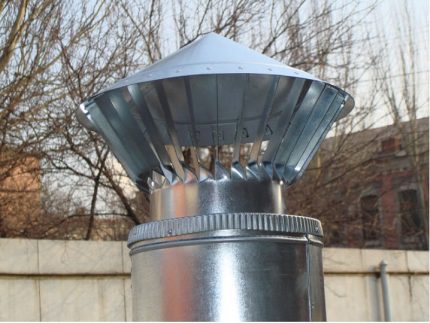
The ventilation umbrella is widely used due to its low price and the possibility of self-production from improvised materials. However, for use in ventilation systems, especially natural ventilation, it is undesirable since it practically does not prevent the occurrence of reverse thrust.
More complex and efficient varieties vent fungus differ from the umbrella by the presence of additional parts, such as a diffuser, rings and blades. The most widely used are TsAGI and Volpert deflectors, turbo deflectors, weathercocks, and similar products.
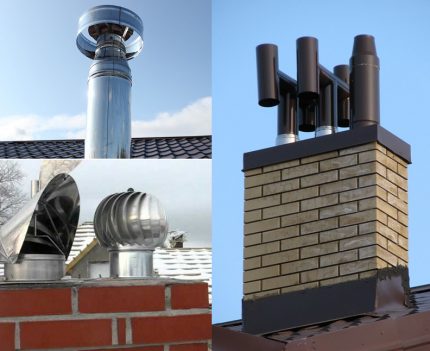
Regardless of the design, all deflectors are united by the ability to increase draft in ventilation during wind. This property is given to them by the specific shape of the parts, enveloping which the wind creates areas with high pressure and rarefaction.
It is in the rarefaction region that air rushes from the ventilation duct, while its speed increases, and the thrust increases accordingly. Most deflectors are energetically passive devices and do not require a power connection.
In addition to the advantages, deflectors have several disadvantages:
- In calm weather, they reduce traction, preventing the free flow of air;
- In cold weather, parts of the device may be covered with hoar frost narrowing the openings for air outlet;
- Turbo deflector and the weather vane umbrella protects against rain worse, and their rotating parts require periodic maintenance and cleaning.
Despite the listed disadvantages, it is necessary to install the ventilation hood on the exhaust pipe. The model of the deflector is selected, focusing on the standard wind load in the area.
In places with low wind activity, in settlements surrounded by forests, the mouth of the hood should be equipped with a turbine deflector.
Umbrella manufacture and installation
The simplest fungus for ventilation can be made by yourself. To do this, you need a galvanized or stainless sheet with a thickness of 0.3-0.5 mm.

From the tool you will need:
- Scissors for metal or grinder;
- Hammer;
- Riveter with rivets;
- Drill or screwdriver with a drill;
- HB gloves.
To fix the clamp on the pipe, an M8 bolt with a nut is required. Instead of rivets during assembly, you can use metal screws, while they will have to be screwed into the clamp from the inside, so that in the future they do not interfere with installation on the ventilation pipe.

The manufacturing process is not complicated and does not require special skills:
- First, on a sheet of metal with permanent marker, we mark the future details: a clamp for mounting on a pipe, three tabs for mounting and an umbrella cap. Cut them with scissors for metal;
- In the clamp around the edges we drill holes for the coupling bolt. We give the clamp a circle shape, and bend the ears with holes at an angle of 90 degrees, insert the bolt, fix it with a nut;
- We drill in the clamp three pairs of holes in the size of the rivets for fastening the legs with an interval of 120 degrees. In each foot for attaching an umbrella, we drill three holes: two on one side for connecting with a clamp and one on the other for connecting with an umbrella. Rivets fasten the legs on the clamp;
- We turn off the umbrella cap in the shape of a cone. In the overlap, we drill several holes and connect the edges of the umbrella with rivets. With an interval of 120 degrees, we drill three holes along the edge of the umbrella and connect it with rivets to the tabs of the clamp. The umbrella is ready.
You can make such an umbrella for ventilation pipes from any material and any size. To install the umbrella, it is necessary to put it with a clamp on the head of the pipe and tighten with a tightening screw and nut.
To give the umbrella cap additional aesthetics and corrosion protection, it can be painted in the color of the ventilation pipe or roof. Any metal paint for outdoor use is suitable for this, since the ventilation umbrella is not exposed to high temperatures.
If you decide to install a factory-made umbrella, you must choose a product that is suitable for your ventilation pipe in terms of size and method of connection.
Selection and installation of exhaust deflector
In contrast to an umbrella, it is quite difficult to make a beautiful and perfectly functioning turbine deflector on your own. Although, if you have patience, a set of tools sufficient for cutting and riveting metal and a proven pattern of blades, this is quite possible.
If there is no desire to get involved with precise cutting, then the Chinese shopping sites actively offer kits for assembling a turbine deflector. The customer of such a set will need to just collect everything according to the instructions and put rivets on each blade.
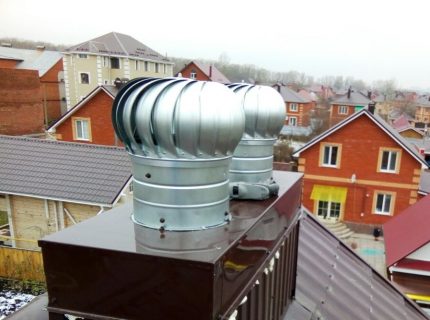
For the right choice of deflector, two main factors must be considered:
- Diameter and design compatible with your vent pipe;
- Correspondence of the deflector to the climatic conditions of the area in which it is to work.
The first indicator guarantees you a tight and reliable fastening of the ventilation umbrella at the exhaust outlet.
Due to the large area of blowing, the deflector experiences strong wind loads, so it must be securely fixed during installation. Also, the connection between the ventilation pipe and the deflector must not have leaks, due to which the ventilation hood may move.
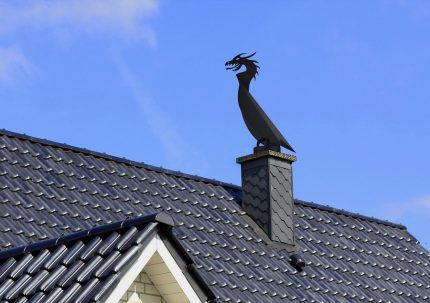
Climatic conditions are also very important. If wind often blows in your area of residence, there is no need to install turbine deflectors and hoods in the form of weathercocks on the hood. They are needed where traction is required to be strengthened by all possible means.
However, they will not be able to work effectively in areas with frequent snowfalls and temperature fluctuations near zero degrees, as they will be covered with ice crust, lose mobility and will not be able to adapt to the direction of the wind flow.
The TsAGI and Volpert deflectors, although less effective in creating traction in the wind, do not have rotating parts that are afraid of icing. Such deflectors are maintenance free and have a lower cost.
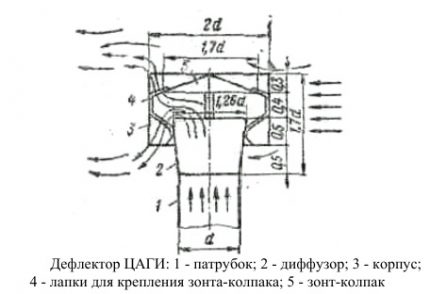
If you correctly selected the deflector for your ventilation pipe, then installing it will not cause difficulties. Deflectors are mounted on the ventilation pipe, as a rule, on clamps or self-tapping screws.

Choosing a deflector with a complex design for the manufacture of a ventilation fungus, make sure that you have the opportunity of convenient maintenance on the roof. After all, even the simplest fungus may require periodic cleaning of hoarfrost or lubrication of rotating parts.
Using ready-made ventilation outlets
If you do not want to understand the intricacies of the operation of ventilation caps and the attractive appearance of the ventilation fungus on your roof is important for you, then you should consider installing a ready-made ventilation outlet.
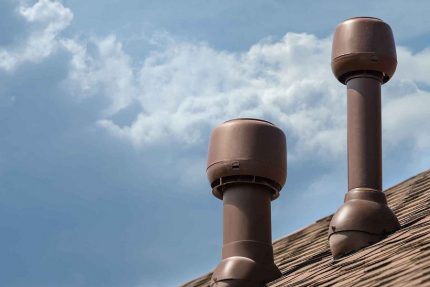
Such outputs are manufactured in the factory and are complete sets of ventilation fungi ready for installation.
The composition of this output includes:
- A feed-through node providing a tight connection to any roof;
- Insulated ventilation outlet, towering above the roof;
- Deflector that provides protection and improves traction;
- Template for easy installation.
Installing a ventilation outlet does not cause difficulties even for beginners.
A hole is cut in the right place in the roof, on which a passage assembly is installed on top of the sealant and self-tapping screws. Next, a heat-insulated outlet with a deflector is attached to the through passage. At the end, the exit under the roof is connected to the exhaust pipe of the internal ventilation system.
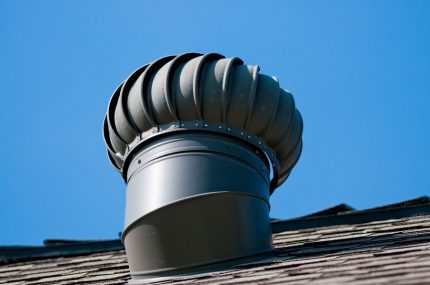
The use of a ready-made ventilation outlet will simplify your choice and allow you to properly make a ventilation fungus for exhaust hoods even with your own hands.
With the nuances and instructions for manufacturing a deflector for the chimney next article, the information of which can also be taken as a basis for those who decided to make a fungus for extraction with their own hands.
Conclusions and useful video on the topic
The video shows the difference in draft in ventilation pipes with and without a deflector-vane:
The following video will introduce the principles of operation and the arrangement of various deflectors:
This video shows the deflector manufacturing process:
The right choice along with the proper installation of a ventilation deflector-fungus is important for creating stable traction in the air exchange system. In addition, any of the ventilation caps prevents precipitation, dust and foreign objects from entering the system channels.
The simplest fungus-deflector Grigorovich can be made independently in the form of an umbrella. If you want to ensure stable draft both in calm and windy weather, then install a deflector on the ventilation pipe, or buy a factory-made ventilation fungus.
Tell us about how you yourself assembled and / or installed the hood on the exhaust pipe. Share the technological subtleties and models of ventilation hoods known only to you. Please leave comments in the block form below, post a photo on the topic of the article, ask questions.

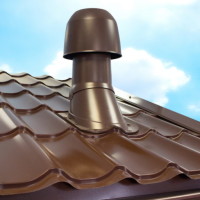 How to increase traction in ventilation: an overview of methods and devices for enhancing traction
How to increase traction in ventilation: an overview of methods and devices for enhancing traction  Nodes of passage of ventilation exhaust shafts: types, features of the choice, application and installation of penetration
Nodes of passage of ventilation exhaust shafts: types, features of the choice, application and installation of penetration  Turbo deflector for ventilation: principle of operation and comparison of types of rotational deflectors
Turbo deflector for ventilation: principle of operation and comparison of types of rotational deflectors  Sandwich pipe for ventilation: installation instructions and the nuances of assembling ventilation from a sandwich pipe
Sandwich pipe for ventilation: installation instructions and the nuances of assembling ventilation from a sandwich pipe  Water heater for fresh air: types, device, model overview
Water heater for fresh air: types, device, model overview 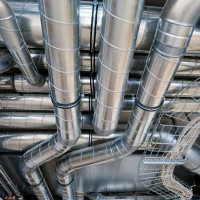 Types of ventilation pipes: a detailed comparative overview of ventilation pipes
Types of ventilation pipes: a detailed comparative overview of ventilation pipes  How much does it cost to connect gas to a private house: the price of organizing gas supply
How much does it cost to connect gas to a private house: the price of organizing gas supply  The best washing machines with dryer: model rating and customer tips
The best washing machines with dryer: model rating and customer tips  What is the color temperature of light and the nuances of choosing the temperature of the lamps to suit your needs
What is the color temperature of light and the nuances of choosing the temperature of the lamps to suit your needs  Replacement of a geyser in an apartment: replacement paperwork + basic norms and requirements
Replacement of a geyser in an apartment: replacement paperwork + basic norms and requirements